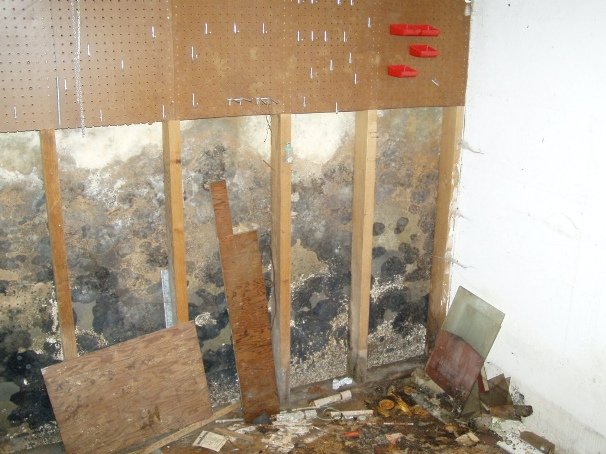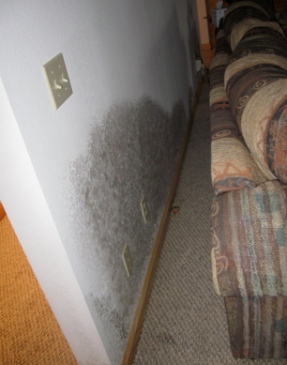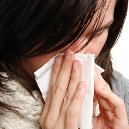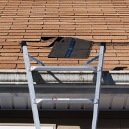Find a pre-screened local mold removal specialist Free Estimate
Find a Mold Specialist Now
Click or Call, Toll-Free 24/7
Black Mold In Home
You’ve probably heard at least a little about the health risks of black mold in home environments. While many types of mold are black in color, when people think about dangerous black mold, they are usually referring to a type of mold whose true name is stachybotrys chartarum. While many types of household mold can cause health problems, stachybotrys chartarum is the most famous, or infamous, and may also be one of the most dangerous to you and your family’s health.
While many molds appear to be dry, stackybotrys is slimy and sooty in appearance. “Stachy” takes longer to develop than other molds and it requires more water/moisture over a longer period of time than other types of mold. Materials with a high cellulose content, like wood, paper, and cardboard are favorite food sources for this toxic black mold. Stachybotrys is a slow developing mold; if you didn’t see it yesterday but you do today, chances are it isn’t stachybotrys. It usually takes one to two weeks for a colony to develop as opposed to the one to two days for most other molds. Once “Stachy” starts it will become the dominant mold and it will usually crowd out other types of mold.
Health Dangers Associated With Black Mold
Media stories and famous law suits have made the public more aware of the dangers of “black”mold. People automatically assume any black mold is toxic mold. The mold itself isn’t necessarily toxic, but the compounds it produces, called mycotoxins, are. If you come into direct contact with these mycotoxins, or inhale the mold’s spores, you can become sick.
Stachybotrys likes to grow in places that stay damp and dark all the time. Places like air conditioner ducts that contain condensation, damp basements, or water-logged structural components. If you have toxic black mold in your HVAC system, every time the blower turns on, your air conditioner blows the mycotoxins and spores out into the air that you and your family breathe.
Exposure to black mold can cause numerous health problems. The toxins tend to cause suppression of your immune system. These health problems include:
- difficulty breathing
- sneezing
- coughing
- sore throats
- itchy and watery eyes
- asthma attacks
- chronic sinus infections
- depression and fatigue
Symptoms can range in severity from mild to very severe. Extended exposure to stachybotrys can eventually result in bleeding in the lungs and damage to the liver and kidneys.
The danger of exposure to black mold in homes is greatest for infants and children, elderly people, pregnant women, and those with pre-existing health problems like asthma, cystic fibrosis, other respiratory problems, and disorders of the immune system. An additional group who needs to stay away from mold exposure is patients who are undergoing chemotherapy treatment. Chemotherapy is designed to weaken a person’s immune system, which in turn weakens their resistance to mold. Exposure to black mold in homes can make anyone sick, including healthy adults. Even your pets are not exempt from the health dangers of exposure to stachybotrys chartarum.
Eliminating Black Mold in Home Environments
The first step in preventing health problems related to exposure to black mold in homes is to eliminate any leaks or water intrusions that allowed the mold to develop. Second, all traces of the mold must be completely removed from the home. Mold often grows in hidden places; if you see any mold, there is a good chance there is more mold you that you can’t see. Mold can grow inside walls, under carpets, above ceiling tiles, below floorboards, inside HVAC systems, inside cabinets, in basements and in crawl spaces. It’s important to remove all traces of mold because if you miss even a little bit, the mold may begin to develop again as soon as any moisture is reintroduced into the area. If this happens, you could have a full-blown mold problem on your hands once more.
It’s often impossible to completely remove mold from porous surfaces like wood and especially drywall. Porous materials need to be cut out, bagged, and removed from the home whenever they are affected by mold contamination. If the wood can't be removed, like wall studs, then they must be cleaned and then sealed by encapsulation. Other non-porous materials, like metal, ceramic tile, laminate or stone countertops, and concrete can usually be successfully cleaned.
Any type of disruption to moldy surfaces can cause the dispersal of mold spores, making them airborne. This can make the symptoms of mold-related illnesses worse. It can also cause mold spores to spread to other previously unaffected areas of the home. Strict safety protocol must be followed in order to avoid making matters worse. Containment chambers should be put into place to isolate affected areas and negative air machines installed to ensure that the mold spores aren’t accidentally spread.
If you have mold-related health problems, or other health problems like asthma that might be made worse by increased exposure to mold, talk to your doctor before attempting to remove mold from your home. Ideally, if you know you are sensitive to mold, you should stay away from any mold and you should also consider possibly leaving your home until the mold issue can be resolved.
For Help With Removal of Black Mold in Home Environments
The U.S. Environmental Protection Agency (EPA) recommends hiring a mold removal professional if you have black mold (or any other type of mold) covering an area greater than three feet by three feet, if you think you may have mold growing in your furnace or your heating and air conditioning ducts, if the issue was caused by sewage or contaminated water, or if you have health problems related to mold exposure and these health problems might be made worse if exposed to mold (like asthma or immune system disorders). We recommend contacting and scheduling a free consultation with a local mold removal professional. Do this even if you plan to attempt the mold removal project yourself. Everyone can benefit from some free, no-obligation, expert advice.
Return From Black Mold In Homes To Our Types Of Mold Page
Source: EPA: Mold Cleanup Guidelines
Free Home Inspection By A Mold Removal Specialist
Search This Website
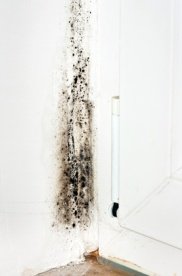 Black mold on wall
Black mold on wallRecent Articles
-
See Our 5 Recommended Mold Removal Companies in Aberdeen, SD
Oct 08, 21 04:05 PM
-
Public Housing Tenant Sick from Mold
Apr 24, 20 01:40 PM
-
Mold Types Found In Homes .......Identification, Finding Mold, Testing
Jan 27, 20 02:32 PM
